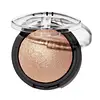What's inside
What's inside
 Key Ingredients
Key Ingredients

 Benefits
Benefits

No benefits
 Concerns
Concerns

 Ingredients Side-by-side
Ingredients Side-by-side

Polyisobutene
Octyldodecanol
EmollientBeeswax
Emulsion StabilisingCopernicia Cerifera Wax
Microcrystalline Wax
Emulsion StabilisingPolyethylene
AbrasiveEthylhexyl Palmitate
EmollientMica
Cosmetic ColorantTalc
AbrasiveSilica
AbrasiveDimethicone
EmollientIsohexyl Neopentanoate
EmollientPhenoxyethanol
PreservativeLanolin
EmollientZea Mays Starch
AbsorbentCI 77891
Cosmetic ColorantCI 77491
Cosmetic ColorantCI 77492
Cosmetic ColorantCI 77499
Cosmetic ColorantNylon-12
Octyldodecyl Stearoyl Stearate
EmollientEthylhexyl Palmitate
EmollientBoron Nitride
AbsorbentSilica
AbrasiveAluminum Starch Octenylsuccinate
AbsorbentBis-Diglyceryl Polyacyladipate-2
EmollientMagnesium Aluminum Silicate
AbsorbentSorbitan Sesquioleate
EmulsifyingPhenoxyethanol
PreservativeDimethicone
EmollientCaprylyl Glycol
EmollientPolyacrylamide
Tocopheryl Acetate
AntioxidantHelianthus Annuus Seed Oil
EmollientPrunus Amygdalus Dulcis Oil
Skin ConditioningVitis Vinifera Seed Oil
EmollientSimmondsia Chinensis Seed Oil
EmollientRosa Canina Fruit Oil
EmollientC13-14 Isoparaffin
EmollientLaureth-7
EmulsifyingTin Oxide
AbrasiveMica
Cosmetic ColorantCI 77891
Cosmetic ColorantCI 77492
Cosmetic ColorantNylon-12, Octyldodecyl Stearoyl Stearate, Ethylhexyl Palmitate, Boron Nitride, Silica, Aluminum Starch Octenylsuccinate, Bis-Diglyceryl Polyacyladipate-2, Magnesium Aluminum Silicate, Sorbitan Sesquioleate, Phenoxyethanol, Dimethicone, Caprylyl Glycol, Polyacrylamide, Tocopheryl Acetate, Helianthus Annuus Seed Oil, Prunus Amygdalus Dulcis Oil, Vitis Vinifera Seed Oil, Simmondsia Chinensis Seed Oil, Rosa Canina Fruit Oil, C13-14 Isoparaffin, Laureth-7, Tin Oxide, Mica, CI 77891, CI 77492
Ingredients Explained
These ingredients are found in both products.
Ingredients higher up in an ingredient list are typically present in a larger amount.
Ci 77492 is also hydrated iron III oxide. It's sole purpose is to give a yellow hue to products.
Iron III oxides are classified as inorganic chemicals for coloring.
Synthetically created Ci 77492 is considered safer than those naturally found. This is because the synthetically created version may contain less impurities. Iron oxides are generally non-toxic and non-allergenic.
Learn more about CI 77492Ci 77891 is a white pigment from Titanium dioxide. It is naturally found in minerals such as rutile and ilmenite.
It's main function is to add a white color to cosmetics. It can also be mixed with other colors to create different shades.
Ci 77891 is commonly found in sunscreens due to its ability to block UV rays.
Learn more about CI 77891Dimethicone is a type of synthetic silicone created from natural materials such as quartz.
What it does:
Dimethicone comes in different viscosities:
Depending on the viscosity, dimethicone has different properties.
Ingredients lists don't always show which type is used, so we recommend reaching out to the brand if you have questions about the viscosity.
This ingredient is unlikely to cause irritation because it does not get absorbed into skin. However, people with silicone allergies should be careful about using this ingredient.
Note: Dimethicone may contribute to pilling. This is because it is not oil or water soluble, so pilling may occur when layered with products. When mixed with heavy oils in a formula, the outcome is also quite greasy.
Learn more about DimethiconeEthylhexyl Palmitate, also known as octyl palmitate, is created from 2-ethylhexyl alcohol and palmitic acid. It is a fatty acid ester.
The fatty acid content of Ethylhexyl Palmitate makes it an emollient. Emollients help soften and hydrate your skin by trapping moisture within.
Ethylhexyl Palmitate is also used to help improve the texture of cosmetics. It helps other ingredient dissolve in products and help disperse ingredients more evenly.
You'll likely find this ingredient in sunscreen, as it is often used to mix UV-blocking ingredients such as avobenzone and ethylhexyl triazone.
It can also help stabilize the fragrances in a product as a fragrance fixative.
Ethylhexyl Palmitate can be used to substitute mineral oil.
Due to its high fatty acid content, it may not be fungal-acne safe.
Learn more about Ethylhexyl PalmitateMica is a naturally occurring mineral used to add shimmer and color in cosmetics. It can also help improve the texture of a product or give it an opaque, white/silver color.
Serecite is the name for very fine but ragged grains of mica.
This ingredient is often coated with metal oxides like titanium dioxide. Trace amounts of heavy metals may be found in mica, but these metals are not harmful in our personal products.
Mica has been used since prehistoric times throughout the world. Ancient Egyptian, Indian, Greek, Roman, Aztec, and Chinese civilizations have used mica.
Learn more about MicaPhenoxyethanol is a preservative that has germicide, antimicrobial, and aromatic properties. Studies show that phenoxyethanol can prevent microbial growth. By itself, it has a scent that is similar to that of a rose.
It's often used in formulations along with Caprylyl Glycol to preserve the shelf life of products.
Silica, also known as silicon dioxide, is a naturally occurring mineral. It is used as a fine, spherical, and porous powder in cosmetics.
Though it has exfoliant properties, the function of silica varies depending on the product.
The unique structure of silica enhances the spreadability and adds smoothness, making it a great texture enhancer.
It is also used as an active carrier, emulsifier, and mattifier due to its ability to absorb excess oil.
In some products, tiny microneedles called spicules are made from silica or hydrolyzed sponge. When you rub them in, they lightly polish away dead skin layers and enhance the penetration of active ingredients.
Learn more about Silica